Poker Games & Rules
From cash games to tournaments, you can enjoy your favorite poker games 24/7. See below for a list of the poker games available and some helpful tips on how to play.
Basic Poker Rules
Many variations of poker exist, but all of them share certain basic rules. Each game involves betting on the strength of your poker hand, and all games feature a ‘pot’ that those bets go into. The player with the strongest hand, or the only player left in the pot after everyone else folds, wins the pot.
All poker games also feature a mandatory bet of some kind. In Hold’em games, this is usually called a ‘blind’ and is wagered when it's one or more players’ turn to post the blinds. In Stud and Draw poker games, this is usually called an ‘ante’ and is wagered every hand, while some games have antes in addition to blinds.
All poker games feature one or more betting rounds in which the player can make one of the following betting choices:
- Check - To not bet, with the option to call or raise later in the betting round
- Bet - To put chips into the pot
- Fold - To release, or ‘muck’, your hand and forfeit any chance of winning the current pot
- Call - To put into the pot an amount of chips equal to the most recent bet or raise
- Raise - To increase the amount of the current bet
When the betting rounds are complete, if there are multiple players still in the pot, there is a ‘showdown’, where the remaining players show their hands to each other. The person with the best hand wins the pot. If there is only one person left in the pot at the end of a betting round (i.e. everyone else folds), that person does not have to show his hand, and they automatically win the pot.
Please review and understand the Poker Hand Rankings before you play.
Texas Hold’em
Texas Hold'em (or simply, ‘Hold'em’) is the most popular poker game in the world. Each player is dealt two cards (‘hole cards’) which belong only to that player. Five community cards are dealt face-up on the ‘board’ and all players may use these cards in conjunction with their own hole cards to make the best five-card poker hand possible. Click here for more on Texas Hold’em Hand Rankings.
6+ Hold'em
This popular 'short deck' format plays much like Texas Hold’em, but with a few exciting differences. All cards lower than a six are removed from the deck, and everyone posts an ante before each hand. Only the button posts a blind – known as the 'button blind'. Unlike traditional hand rankings, a flush beats a full-house and Ace, 6, 7, 8, 9 is classified as a straight.
Showtime Hold’em
Showtime Hold’em plays almost identically to Texas Hold’em (see above), with the exception that every card folded by any player remains face-up and visible for the rest of the hand. This includes all cards folded before and after the flop.
Omaha High
Omaha is similar to Texas Hold’em in some ways, but the players receive four hole cards, and the hand must consist of exactly two cards from the player’s hole cards and exactly three cards from the board. (In Texas Hold’em the hands can consist of any combination of board and hole cards.)
Omaha High is a popular variation of poker in Europe, especially in pot limit. PokerStars offers Omaha in both limit and pot limit for all our players around the world.
Omaha Hi/Lo
Omaha Hi/Lo, or Omaha Eight (played with an ‘eight or better’ qualifier for low), is offered in limit, pot limit and no limit action.
Swap Hold’em
Swap Hold'em is a great twist on the world’s favorite poker game, Texas Hold’em. The twist is that before any player has the option to fold, they are first given the chance to swap out one or both of their hole cards for new ones. Players can swap once per hand, at any point in the hand (either pre- or post-flop) unless they are all-in.
Split Hold’em
Split Hold’em is a novel twist on the classic and wildly popular game of Texas Hold’em. What makes Split Hold’em different is that two completely separate boards are dealt simultaneously – two flops, two turns and two rivers – with the winner of each board receiving half the pot.
Tempest Hold'em
This unique format ups the ante on traditional Texas Hold'em games. Not only do the antes increase every hand until a showdown is reached, but there's an extra pre-flop blind – known as a Giant Blind – and you only have two options: all-in or fold. Hands play out per regular Texas Hold'em rules (see above), but every pot is 'capped'. That means no player can wager or lose more than 10 Giant Blinds in a single hand.
5 Card Omaha and 5 Card Omaha Hi/Lo
5 Card Omaha and 5 Card Omaha Hi/Lo are similar in some ways to regular Omaha games, but with a fifth hole card dealt to each player pre-flop. 5 Card Omaha games are available at pot limit and no limit tables, while Hi/Lo games can be played at Limit, pot Limit and no Limit tables.
Courchevel and Courchevel Hi/Lo
Courchevel is an exciting form of 5 Card Omaha, where the first flop card is dealt face up at the beginning of the hand. Courchevel Hi/Lo is a popular split pot form of Omaha poker, where each player is dealt five cards pre-flop. You can play Courchevel and Courchevel Hi/Lo for free at limit, pot limit and no limit tables.
Seven Card Stud and Seven Card Stud Hi/Lo
Seven Card Stud is a classic poker game in which players are dealt seven cards throughout the course of the hand, but only the best five-card hand possible for each player is used to determine the winner. The split pot version of Seven Card Stud Hi/Lo offers a twist to this much-loved game and is played with an ‘eight or better’ qualifier, meaning that a hand must be, at worst, an eight-low to be eligible to win the low portion of the pot.
Razz (7 Card Stud Low)
If you think you can never make a hand, Razz is the game for you. This version of seven-card lowball allows you to aim for the absolute worst five-card hand and still win. The ante and playing structure of Razz is exactly the same as Seven Card Stud except it is played for low instead of high. Straights and flushes are ignored, so the best possible hand is 5, 4, 3, 2, A.
Five Card Draw
In Five Card Draw, the idea is to make the best five-card hand after one ‘draw’ – or substitution of unwanted cards. Players are dealt five hole cards, and once the first round of betting is complete, players select the hole cards they wish to discard (if any) by clicking on them. You can change your mind by clicking on the card(s) a second time. Once players in the hand have completed their draws there is another round of betting, and the winner is either the player left after everyone else has folded, or the player with the best five-card hand.
2-7 Single Draw and 2-7 Triple Draw
2-7 Single Draw and 2-7 Triple Draw are lowball games that force you to make the worst possible low hand. In 2-7 Single Draw, players can discard unwanted cards after the first round of betting. In 2-7 Triple Draw, players can discard unwanted cards after each of the first three rounds of betting. In 2-7 games, an Ace is *always* a high card, and straights and flushes count against you, so in both games, the lowest possible hand is 7, 5, 4, 3, 2 of different suits. Please review the 2-7 hand ranking system below before playing either of these exciting poker games.
HORSE & 8-Game Mix (Mixed games)
HORSE (Hold'em, Omaha, Razz, Seven Card Stud, Seven Card Stud Eight-or-Better) is the collection of games that allows you to prove how well-rounded a poker player you are. If you get bored playing one game all the time, try out HORSE to round out your skills. We also offer 8-Game Mix, which is the same rotation as HORSE, but also includes rounds of No Limit Hold’em, Pot Limit Omaha and 2-7 Triple Draw.
Badugi
Badugi is a form of draw poker, where the object of the game is to make the best low hand of different suits, from the four cards you are dealt. After the first betting round, remaining players can discard unwanted cards and draw. Another round of betting then ensues, after which there are two more draw and betting rounds. It's important to understand that in Badugi, pairs and suited cards don't count at all; a 'badugi' is a hand of four different ranks and all four suits. The best hand possible is 4, 3, 2, A, of different suits. Please review the Badugi hand ranking system below before playing.
Fusion
This format mixes elements of Texas Hold'em and Omaha. Start with two hole cards and receive more as the hand continues. If you play through to the river, you’ll have four hole cards and five community cards from which to make your best five-card hand.
Poker Hand Rankings
We deal many varieties of poker, some of which use different hand rankings. Hold’em, Omaha, Seven Card Stud and Five Card Draw all use the traditional ‘high’ poker rankings. Omaha Hi/Lo, Razz and Stud Hi/Lo use the ‘Ace to Five’ (‘California’) low hand rankings for low hands. 2-7 Single Draw and 2-7 Triple Draw use the ‘Deuce to Seven’ (‘Kansas City’) lowball rankings for low hands. Lastly, Badugi uses a special ranking of hands unique to that game.
Straight Flush: Five cards in sequence, of the same suit.
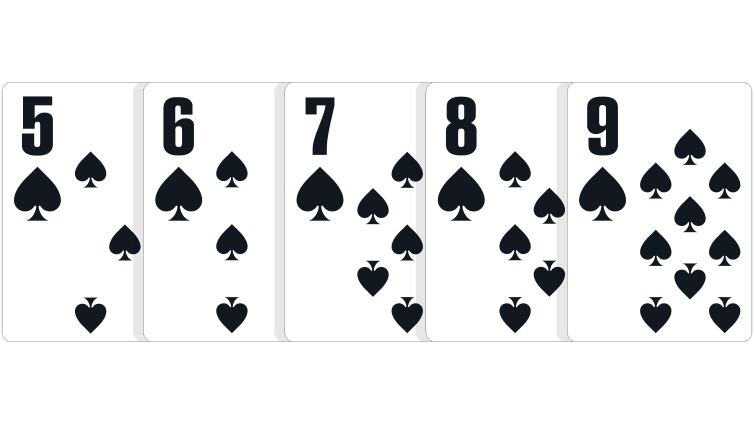
In the event of a tie: Highest rank at the top of the sequence wins.
The best possible straight flush is known as a royal flush, which consists of the ace, king, queen, jack and ten of a suit. A royal flush is an unbeatable hand.
Four of a Kind: Four cards of the same rank, and one side card or ‘kicker’.
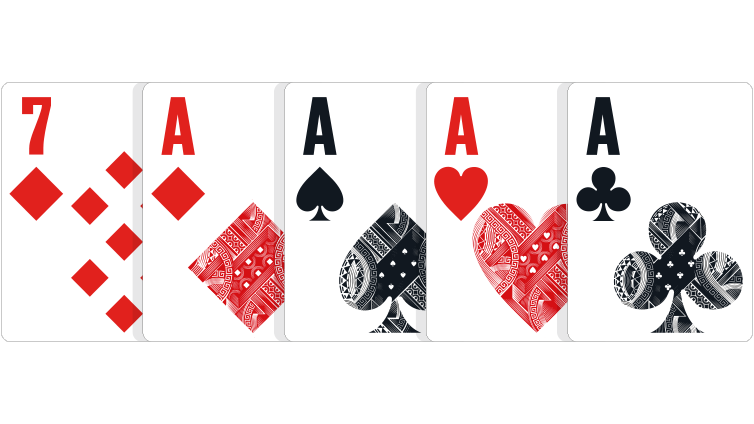
In the event of a tie: Highest four of a kind wins. In community card games where players have the same four of a kind, the highest fifth side card ('kicker') wins.
Full House: Three cards of the same rank, and two cards of a different, matching rank.
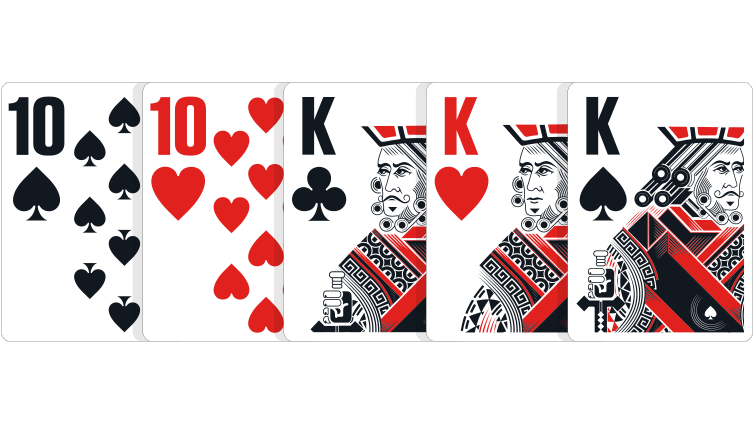
In the event of a tie: Highest three matching cards wins the pot. In community card games where players have the same three matching cards, the highest value of the two matching cards wins.
Flush: Five cards of the same suit.
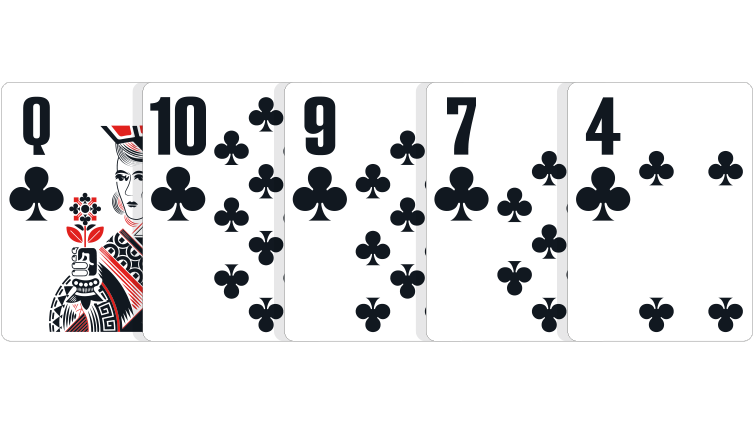
In the event of a tie: The player holding the highest ranked card wins. If necessary, the second-highest, third-highest, fourth-highest, and fifth-highest cards can be used to break the tie. If all five cards are the same ranks, the pot is split. The suit itself is never used to break a tie in poker.
Straight: Five cards in sequence.
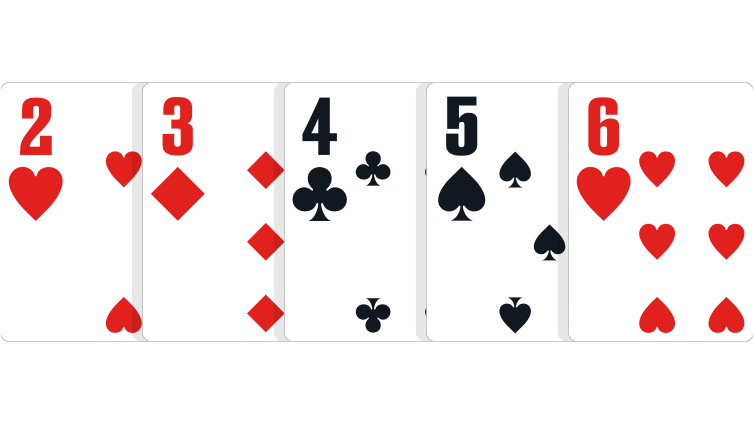
In the event of a tie: Highest ranking card at the top of the sequence wins.
Note: The Ace may be used at the top or bottom of the sequence, and is the only card which can act in this manner. A,K,Q,J,T is the highest (Ace high) straight; 5,4,3,2,A is the lowest (Five high) straight.
Three of a kind: Three cards of the same rank, and two unrelated side cards.
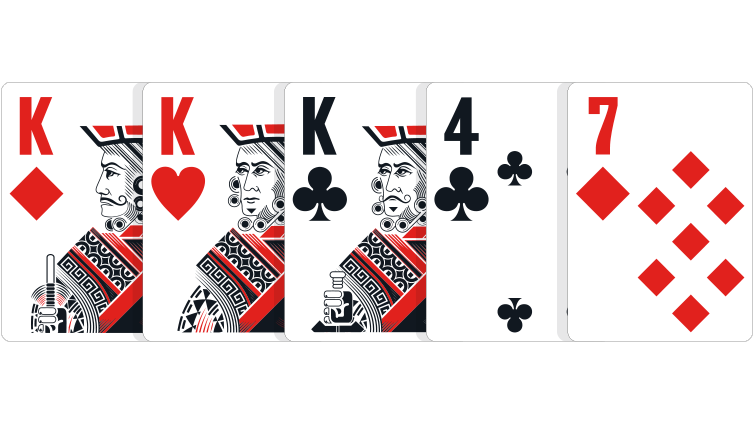
In the event of a tie: Highest ranking three of a kind wins. In community card games where players have the same three of a kind, the highest side card, and if necessary, the second-highest side card wins.
Two pair: Two cards of a matching rank, another two cards of a different matching rank, and one side card.
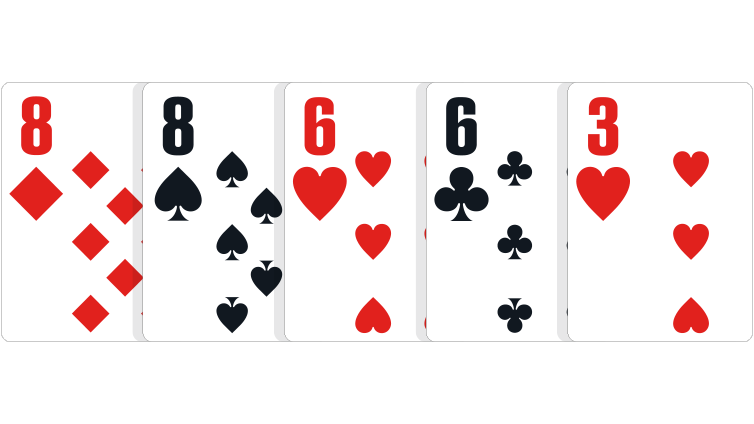
In the event of a tie: Highest pair wins. If players have the same highest pair, highest second pair wins. If both players have two identical pairs, highest side card wins.
One pair: Two cards of a matching rank, and three unrelated side cards.

In the event of a tie: Highest pair wins. If players have the same pair, the highest side card wins, and if necessary, the second-highest and third-highest side card can be used to break the tie.
High card: Any hand that does not qualify under a category listed above.

In the event of a tie: Highest card wins, and if necessary, the second-highest, third-highest, fourth-highest and smallest card can be used to break the tie.
This method of ranking low hands is used in traditional Hi/Lo games, like Omaha Hi/Lo and Stud Hi/Lo, as well as in Razz, the ‘low only’ Stud game.
Note that suits are irrelevant for Ace to Five low. A flush or straight does not ‘break’ an Ace to Five low poker hand. Aces are always a ‘low’ card when considering a low hand.
Please also note that the value of a five-card low hand starts with the top card, and goes down from there.
Five Low, or Wheel: The Five, Four, Three, Deuce and Ace.

In the event of a tie: All Five-high hands split the pot.
Six Low: Any five unpaired cards with the highest card being a Six.
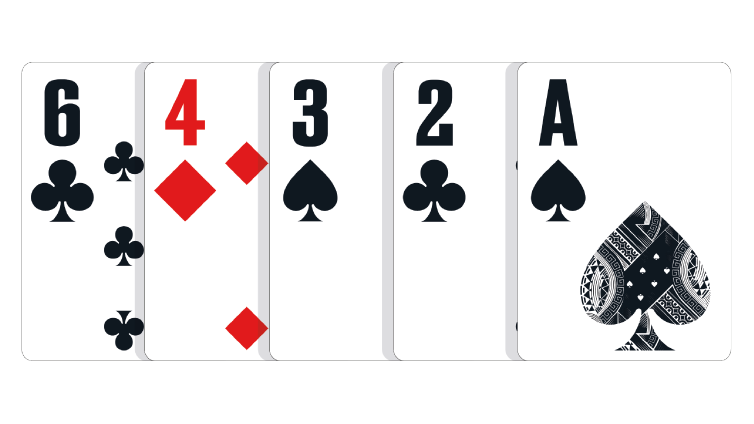
In the event of a tie: The lower second-highest ranking card wins the pot. Thus 6,4,3,2,A defeats 6,5,4,2,A. If necessary, the third-highest, fourth-highest and fifth-highest cards in the hand can be used to break the tie.
Seven Low: Any five unpaired cards with the highest card being a Seven.

In the event of a tie: The lower second-highest ranking card wins the pot. If necessary, the third-highest, fourth-highest and fifth-highest cards in the hand can be used to break the tie.
Eight Low: Any five unpaired cards with the highest card being an Eight.
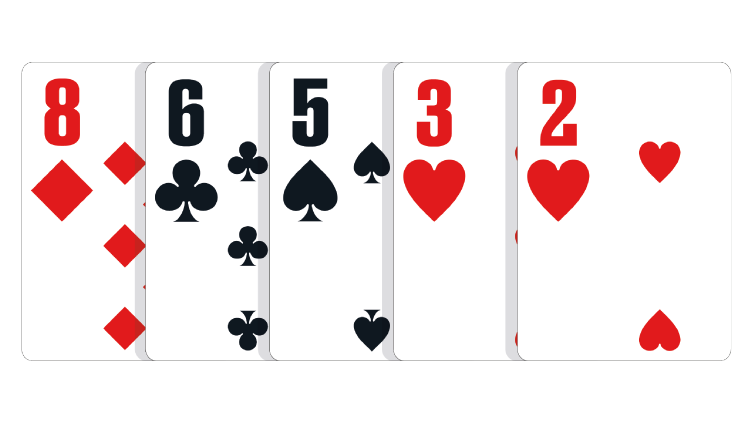
In the event of a tie: The lower second-highest ranking card wins the pot. If necessary, the third-highest, fourth-highest and fifth-highest cards in the hand can be used to break the tie.
An Eight Low is the weakest hand that qualifies for low in Omaha Hi/Lo and Stud Hi/Lo. However in Razz, there is no such ‘qualifier’ and the lowest hand will always win the pot, even if it is a nine low, queen low, or even a pair!
The 2-7 Lowball hand rankings are the exact opposite of the traditional ‘high’ hand rankings. Therefore, the worst possible hand in traditional high poker – seven-deuce high, with different suits, becomes the best possible hand in 2-7 lowball (a ‘perfect seven’ low or ‘wheel’).
In practice, an ace always plays as a high card in 2-7 (so A,5,4,3,2 is an ace high, not a straight). Straights and flushes count against your hand in 2-7.
Seven Low: Any five unpaired, unconnected cards of different suits, with the highest card being a seven. The best possible hand is 7,5,4,3,2, also known as a ‘wheel’ or ‘number one’.

In the event of a tie: The lower second card wins the pot. Thus 7,5,4,3,2 beats 7,6,5,3,2 (a ‘Seven-Five low’ is better than a ‘Seven-Six low’). If necessary, the third-highest, fourth-highest and fifth-highest cards in the hand can be used to break the tie.
Eight Low: Any five unpaired, unconnected cards of different suits, with the highest card being an eight.

In the event of a tie: The lower second card wins the pot. If necessary, the third-highest, fourth-highest and fifth-highest cards in the hand can be used to break the tie.
Nine Low: Any five unpaired, unconnected cards of different suits, with the highest card being a nine.
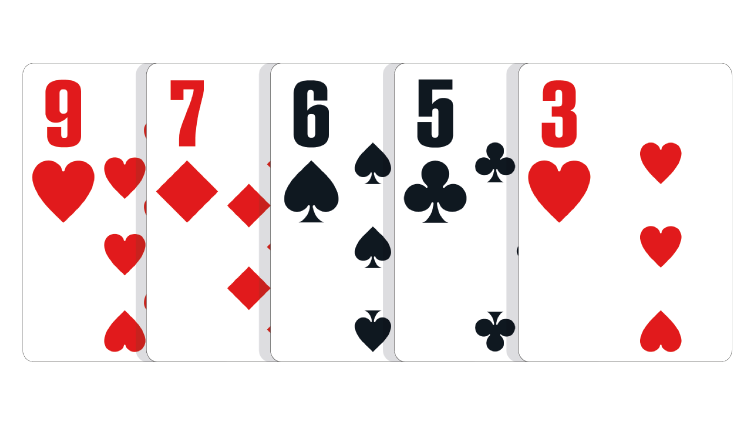
In the event of a tie: The lower second card wins the pot. If necessary, the third-highest, fourth-highest and fifth-highest cards in the hand can be used to break the tie.
Ten Low: Any five unpaired, unconnected cards of different suits, with the highest card being a ten.

In the event of a tie: The lower second card wins the pot. If necessary, the third-highest, fourth-highest and fifth-highest cards in the hand can be used to break the tie.
Note: There is no ‘qualifier’ for low in 2-7 lowball games. The above are just examples of hands that may come up in play – the lowest hand will always win the pot in 2-7, even if it is a pair or worse!
Badugi does not use traditional poker hand rankings and it takes some practice to learn how to correctly read the hands. Badugi hand rankings are somewhat related to the Ace to Five rankings; like in Ace to Five, an ace always plays as a low card. However, unlike Ace to Five, each card in your hand must be a different suit and a different rank, in order to count.
Badugi hands consist of four cards, instead of the usual five. Because of this it is impossible to make a five-card straight, and having four cards in sequence does not hurt your hand.
Remember, if you have cards of the same suit, only one of them counts, and if you have pairs, only one of them counts.
Badugi: A badugi is any hand which consists of four unpaired cards, each a different suit.

In the event of a tie: The lower second card wins the pot. If necessary, the third-highest and fourth-highest cards in the hand can be used to break the tie.
Three-Card Hand: Any hand consisting of three unpaired cards of different suits, but a fourth paired or suited card. The lowest three unpaired cards of different suits play.
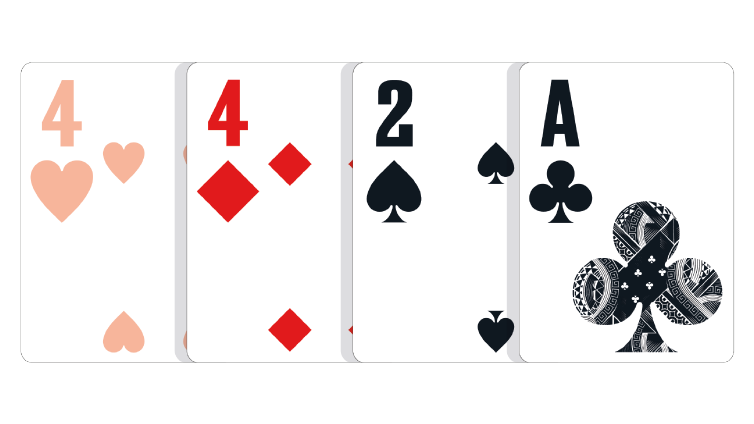
Because there is a pair, one of the fours does not count, so it is simply ignored, making a 4,2,A three-card hand.
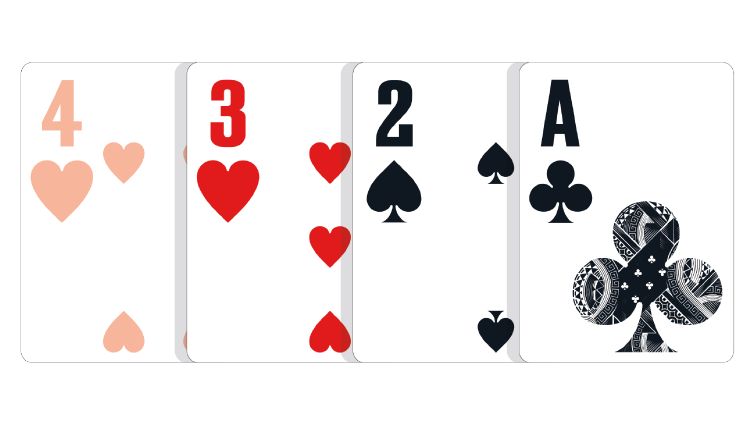
Because there are two hearts in this hand, one of them is ignored, making a 3,2,A three-card hand.
In the event of a tie: The lower second card wins the pot. If necessary, the third-highest card in the hand can be used to break the tie. The fourth (paired or suited) card does not count toward the hand and is not used to break ties.
Two-Card Hand: Any hand consisting of two unpaired cards of different suits, but two paired or suited cards. The lowest two unpaired cards of different suits play.
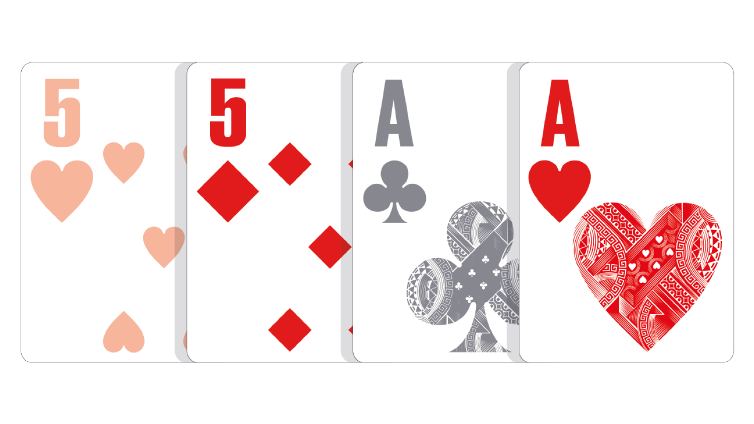
Because there are two pairs, one of each pair is discarded, making a 5,A two-card hand.
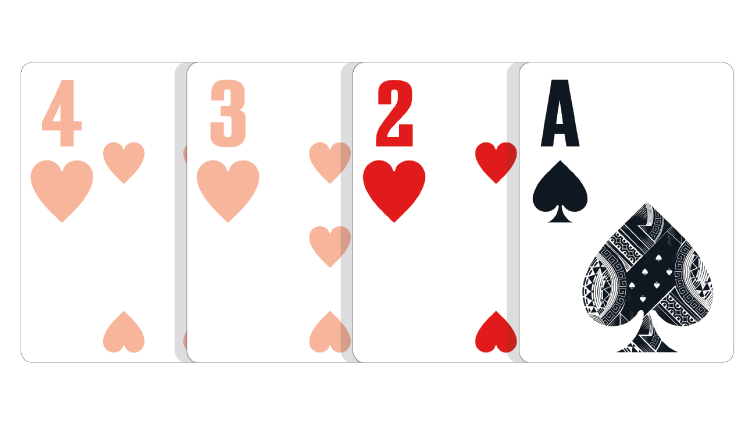
Because there are three hearts, two of them are discarded, making a 2,A two-card hand.
In the event of a tie: The lower second card wins the pot. The third and fourth (paired or suited) cards do not count toward the hand and are not used to break ties.
One-Card Hand: A hand consisting of only one playable card. The lowest card plays.

Since there are four Aces, three of them are discarded, making a one-card hand of just an Ace.

Since there are four cards of the same suit, three of them are discarded, making a one-card hand of just a Three.
In the event of a tie: The pot is split between two equal one-card hands.